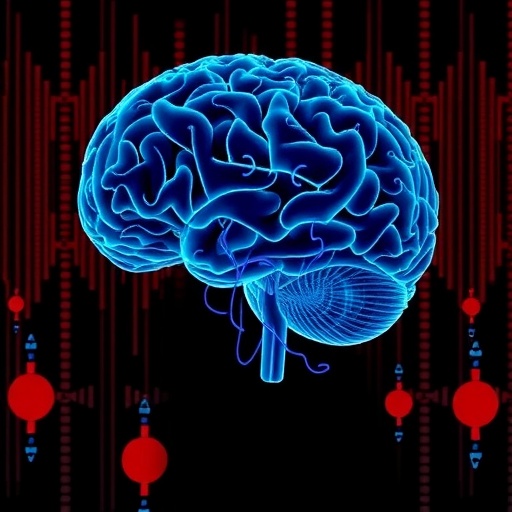In a groundbreaking advance that reverberates through the field of psychiatry and neuropharmacology, researchers have unveiled novel electroencephalographic (EEG) biomarkers with the potential to revolutionize treatment paradigms for schizophrenia. This discovery, detailed in the forthcoming article by Siekmeier and Coyle in Translational Psychiatry, promises to sharpen our ability to predict which patients will respond favorably to an innovative glutamatergic agent—an experimental drug targeting glutamate pathways implicated in schizophrenia’s complex neurobiology.
Schizophrenia, a chronic and often debilitating psychiatric disorder, has historically posed formidable challenges for clinicians. Variability in drug response and the significant side effects associated with many antipsychotic medications underscore the urgent need for approaches that can individualize treatment and improve outcomes. Traditional dopamine-based treatments, while effective for many, fail to address the heterogeneous neurochemical dysfunctions underpinning the disorder. Enter glutamate, the brain’s primary excitatory neurotransmitter, whose dysregulation is increasingly recognized as a critical factor in schizophrenia’s pathophysiology.
The study harnesses advanced EEG analytics to capture subtle electrophysiological signatures predictive of therapeutic response, dissecting the cortical oscillatory dynamics modulated by glutamatergic signaling. EEG, a non-invasive technique that records the brain’s electrical activity, provides a real-time window into neural connectivity and excitatory-inhibitory balance, both of which are disrupted in schizophrenia. By focusing on these electrophysiological markers, the research navigates beyond symptomatic profiling toward a neurobiologically informed biomarker-driven prediction model.
What distinguishes this work is its emphasis on precision psychiatry. The prospect of identifying responders before drug administration holds vast clinical implications. Patients who exhibit specific EEG biomarker profiles could be stratified to receive glutamatergic agents while sparing non-responders from ineffective treatments and their attendant side effects. This biomarker stratification paradigm not only economizes healthcare resources but also elevates the standard of care by aligning pharmacotherapy with individual neurophysiological substrates.
The electrophysiological features identified hinge on gamma-band oscillations within the cortical circuits, synchronizations that are pivotal for cognitive functions such as working memory and attention. Aberrations in gamma activity have been repeatedly implicated in schizophrenia, particularly in relation to glutamatergic neurotransmission at NMDA receptors. The researchers demonstrate that modulation of these oscillations in response to the glutamatergic agent correlates strongly with clinical improvement, providing an objective, quantifiable measure of drug efficacy.
Methodologically, the study employed rigorous EEG recording sessions before and after administration of the experimental agent, extracting multidimensional spectral parameters with sophisticated signal processing algorithms. The application of machine learning techniques further optimized the identification of patterns predictive of therapeutic outcomes. Such a combination of neurophysiological measurement and computational modeling epitomizes the cutting edge of translational neuroscience research.
Furthermore, the findings challenge prevailing conceptual frameworks by highlighting the glutamate system’s central role in mediating cortical network dynamics disrupted in schizophrenia. This sheds light on the previously elusive neurobiological underpinnings of treatment resistance and cognitive deficits, domains often resistant to dopaminergic modulation. The therapeutic candidate examined acts primarily on glutamate receptors, underscoring a mechanistically innovative strategy in the psychopharmacological arsenal.
Importantly, this research bridges the gap between experimental pharmacology and clinical psychiatry, demonstrating that EEG biomarkers can serve not only as diagnostic adjuncts but as functional indicators of pharmacodynamic response. This dual utility reinforces the growing consensus advocating for biomarker integration into psychiatric drug development and clinical trial design, potentially accelerating the delivery of new treatments to patients.
The clinical impact of this advancement extends beyond drug response prediction. It sets a precedent for incorporating electrophysiological biomarkers into routine psychiatric assessments, potentially enabling more dynamic and responsive treatment algorithms. By quantifying brain network alterations at baseline and their modulation upon drug exposure, psychiatrists could tailor interventions with unprecedented granularity and precision.
Moreover, this approach has wider methodological implications. It exemplifies how electrophysiological signals, traditionally relegated to research domains, can be translated into actionable clinical tools. This paradigm encourages the continued refinement of neuroimaging and bioelectrical recording techniques, aligned with artificial intelligence, to unlock personalized medicine’s full potential in mental health.
While these findings are a landmark, they also pave the way for future research directions. Validation across larger, diverse cohorts and replication in multicenter trials will be essential to corroborate the biomarker profiles’ robustness. Additionally, understanding how these EEG markers interact with other biological and genetic factors could enrich their predictive power and lead to integrative biomarker models.
Furthermore, gaining mechanistic insights into how glutamatergic modulation reshapes neural oscillatory patterns could illuminate novel targets for intervention. This could spur the development of adjunctive therapies designed to normalize cortical circuitry dysfunctions, potentially ameliorating not only psychosis but also cognitive and negative symptoms that have long eluded effective treatment.
Ultimately, the identification of EEG biomarkers predictive of glutamatergic agent responsiveness marks a dramatic stride toward personalized psychiatry. It encapsulates the synergy of neuroscience, advanced data analytics, and clinical innovation, culminating in a beacon of hope for patients with schizophrenia grappling with the uncertainties of treatment efficacy. As this research translates into clinical practice, it holds the promise of enhancing therapeutic precision, reducing trial-and-error prescribing, and dramatically improving patient quality of life.
In a field where progress can be painstakingly incremental, this discovery signals a new era wherein neurophysiological data drives individualized treatment strategies. It embodies a movement away from one-size-fits-all psychiatry toward a future where the brain’s own signals guide clinicians in unlocking the best path forward for each patient—a paradigm shift with profound therapeutic and societal implications.
As the science pushes forward, the psychiatric community and patients alike will watch keenly as these EEG biomarkers transition from laboratory validation to clinical utility. The road ahead will demand collaborative efforts among neuroscientists, clinicians, and bioengineers to harness the full potential of these insights and ensure their equitable implementation in mental health care worldwide.
Subject of Research: Electroencephalographic biomarkers predicting response to glutamatergic treatment in schizophrenia
Article Title: Novel electroencephalographic biomarkers for the prediction of responders to an experimental glutamatergic agent in patients with schizophrenia
Article References:
Siekmeier, P.J., Coyle, J.T. Novel electroencephalographic biomarkers for the prediction of responders to an experimental glutamatergic agent in patients with schizophrenia. Transl Psychiatry 15, 390 (2025). https://doi.org/10.1038/s41398-025-03604-z
Image Credits: AI Generated




